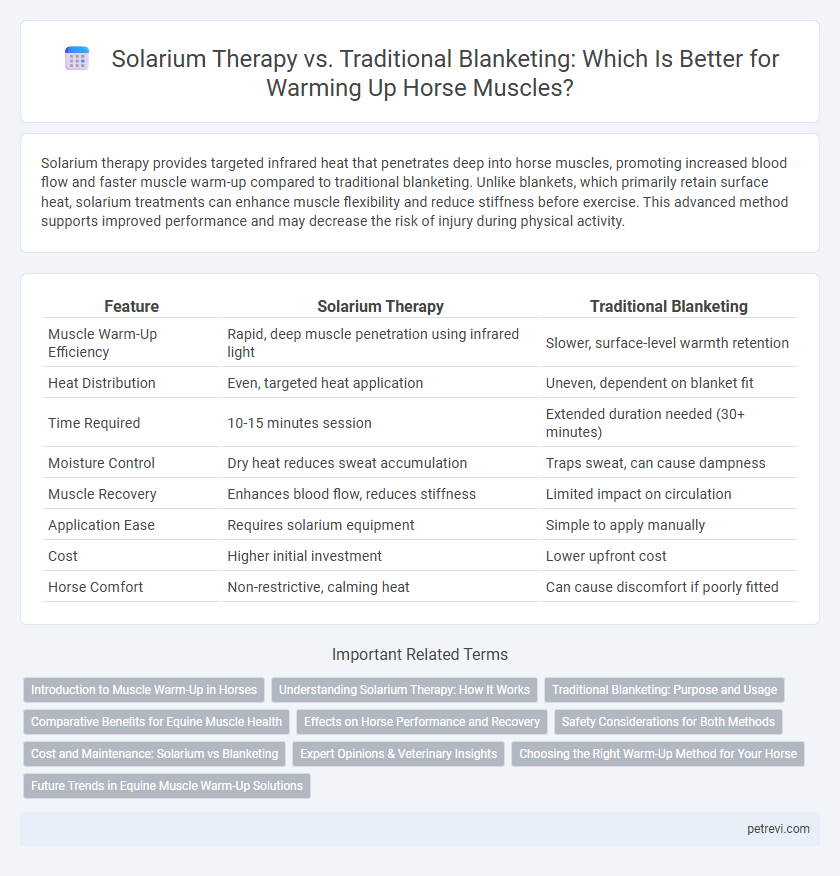Solarium therapy provides targeted infrared heat that penetrates deep into horse muscles, promoting increased blood flow and faster muscle warm-up compared to traditional blanketing. Unlike blankets, which primarily retain surface heat, solarium treatments can enhance muscle flexibility and reduce stiffness before exercise. This advanced method supports improved performance and may decrease the risk of injury during physical activity.
Table of Comparison
| Feature | Solarium Therapy | Traditional Blanketing |
|---|---|---|
| Muscle Warm-Up Efficiency | Rapid, deep muscle penetration using infrared light | Slower, surface-level warmth retention |
| Heat Distribution | Even, targeted heat application | Uneven, dependent on blanket fit |
| Time Required | 10-15 minutes session | Extended duration needed (30+ minutes) |
| Moisture Control | Dry heat reduces sweat accumulation | Traps sweat, can cause dampness |
| Muscle Recovery | Enhances blood flow, reduces stiffness | Limited impact on circulation |
| Application Ease | Requires solarium equipment | Simple to apply manually |
| Cost | Higher initial investment | Lower upfront cost |
| Horse Comfort | Non-restrictive, calming heat | Can cause discomfort if poorly fitted |
Introduction to Muscle Warm-Up in Horses
Muscle warm-up in horses is essential to increase blood flow, enhance flexibility, and reduce injury risk during exercise. Solarium therapy uses infrared heat to penetrate deep muscle tissues, promoting faster relaxation and improved circulation compared to traditional blanketing methods. Traditional blanketing primarily provides surface warmth, which may be less effective in achieving optimal muscle temperature and readiness.
Understanding Solarium Therapy: How It Works
Solarium therapy utilizes infrared heat to penetrate deep into horse muscles, enhancing blood circulation and accelerating muscle warm-up more effectively than traditional blanketing. Unlike blankets that provide surface-level insulation, solarium lamps stimulate muscle fibers, reducing stiffness and improving overall flexibility. This targeted heat therapy supports quicker recovery post-exercise and helps maintain optimal muscle condition in horses.
Traditional Blanketing: Purpose and Usage
Traditional blanketing serves as an essential method for maintaining equine muscle warmth and preventing stiffness, particularly in colder climates or during early exercise routines. Blankets made from materials like wool or fleece provide consistent insulation, helping to preserve core body temperature and improve circulation in muscles. This time-tested approach supports muscle flexibility and reduces the risk of injury by protecting horses from cold stress before and after physical activity.
Comparative Benefits for Equine Muscle Health
Solarium therapy provides targeted infrared heat that penetrates deep into equine muscles, enhancing blood circulation and accelerating recovery compared to traditional blanketing methods. Traditional blanketing primarily offers surface warmth, which may not effectively stimulate muscle fibers or reduce stiffness after intense exercise. Horses receiving solarium sessions often exhibit improved muscle elasticity and reduced soreness, promoting better overall muscle health and performance.
Effects on Horse Performance and Recovery
Solarium therapy provides targeted infrared heat that penetrates deep into the horse's muscles, enhancing blood circulation and promoting faster muscle warm-up compared to traditional blanketing. Improved muscle elasticity and reduced stiffness from solarium exposure contribute to increased performance levels and more efficient recovery after intense exercise. Traditional blanketing mainly offers surface warmth and protection from cold, which may delay optimal muscle activation and slower post-workout recovery.
Safety Considerations for Both Methods
Solarium therapy provides controlled infrared heat that warms horse muscles without the risk of overheating or restricted movement commonly associated with traditional blanketing. Traditional blankets, if improperly fitted or used in extreme conditions, can cause overheating, sweating, or skin irritation, posing safety risks during muscle warm-up. Both methods require careful monitoring of temperature and horse response to ensure optimal muscle preparation and prevent injury.
Cost and Maintenance: Solarium vs Blanketing
Solarium therapy for horses involves a higher initial investment due to equipment costs but offers low ongoing maintenance and energy expenses, making it cost-effective over time. Traditional blanketing requires frequent replacement and cleaning, leading to recurring costs in purchases and labor. Evaluating long-term expenses, solarium therapy provides efficient muscle warm-up with reduced maintenance compared to the cyclical costs of traditional blanketing.
Expert Opinions & Veterinary Insights
Veterinary experts emphasize solarium therapy's ability to penetrate deep tissues, promoting muscle relaxation and enhancing blood circulation more effectively than traditional blanketing. Studies show solarium use before exercise reduces muscle stiffness and accelerates recovery, while blanketing primarily maintains surface warmth without influencing underlying muscles. Equine specialists recommend combining solarium sessions with warm-up exercises for optimal muscle performance and injury prevention.
Choosing the Right Warm-Up Method for Your Horse
Solarium therapy provides infrared heat that penetrates deeply into horse muscles, enhancing blood circulation and muscle elasticity more effectively than traditional blanketing. While traditional blanketing maintains surface warmth to prevent heat loss, it lacks the therapeutic benefits crucial for muscle recovery and injury prevention. Selecting the right warm-up method depends on your horse's specific needs, such as muscle stiffness, environment, and performance demands, with solarium therapy offering advanced warm-up advantages for athletic horses.
Future Trends in Equine Muscle Warm-Up Solutions
Solarium therapy is emerging as a cutting-edge alternative to traditional blanketing for equine muscle warm-up, leveraging infrared heat to enhance blood circulation and reduce muscle stiffness more efficiently. Future trends point toward integrating smart technology with solarium systems, enabling precise temperature control and personalized treatments based on real-time muscle condition monitoring. Advancements in wearable sensors and AI-driven diagnostics will likely revolutionize muscle warm-up protocols, optimizing recovery and performance for horses while minimizing injury risks.
Solarium Therapy vs Traditional Blanketing for Horse Muscle Warm-Up Infographic

 petrevi.com
petrevi.com